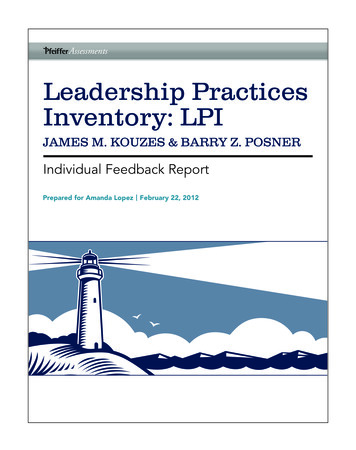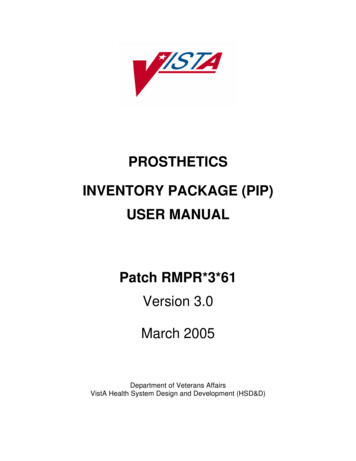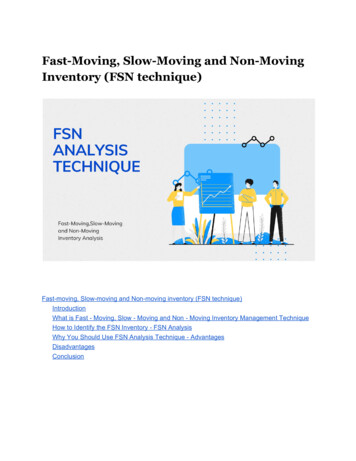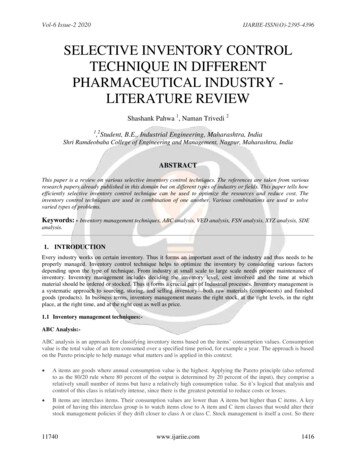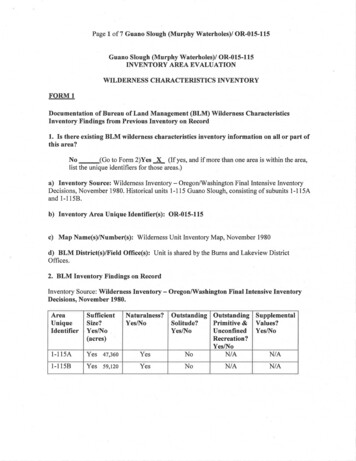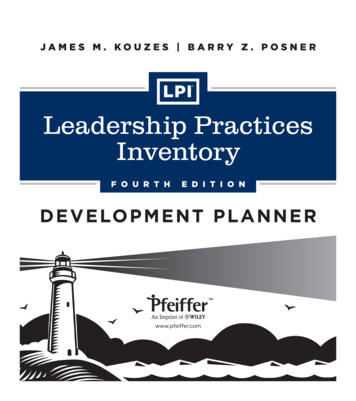
Transcription
Leadership PracticesInventoryffirs.indd i8/22/12 12:50 AM
Copyright 2013 by James M. Kouzes & Barry Z. Posner. All Rights Reserved.Published by PfeifferAn Imprint of WileyOne Montgomery Street, Suite 1200, San Francisco, CA 94104-4594www.pfeiffer.comNo part of this publication may be reproduced, stored in a retrieval system, or transmitted in any form or byany means, electronic, mechanical, photocopying, recording, scanning, or otherwise, except as permittedunder Section 107 or 108 of the 1976 United States Copyright Act, without either the prior written permissionof the Publisher, or authorization through payment of the appropriate per-copy fee to the CopyrightClearance Center, Inc., 222 Rosewood Drive, Danvers, MA 01923, 978-750-8400, fax 978-646-8600, oron the web at www.copyright.com. Requests to the Publisher for permission should be addressed to thePermissions Department, John Wiley & Sons, Inc., 111 River Street, Hoboken, NJ 07030, 201-748-6011,fax 201-748-6008, or online at http://www.wiley.com/go/permissions.Limit of Liability/Disclaimer of Warranty: While the publisher and author have used their best effortsin preparing this book, they make no representations or warranties with respect to the accuracy orcompleteness of the contents of this book and specifically disclaim any implied warranties of merchantabilityor fitness for a particular purpose. No warranty may be created or extended by sales representatives orwritten sales materials. The advice and strategies contained herein may not be suitable for your situation.You should consult with a professional where appropriate. Neither the publisher nor author shall be liablefor any loss of profit or any other commercial damages, including but not limited to special, incidental,consequential, or other damages. Readers should be aware that Internet websites offered as citations and/or sources for further information may have changed or disappeared between the time this was written andwhen it is read.For additional copies/bulk purchases of this book in the U.S. please contact 800-274-4434.Pfeiffer books and products are available through most bookstores. To contact Pfeiffer directly callour Customer Care Department within the U.S. at 800-274-4434, outside the U.S. at 317-572-3985,fax 317-572-4002, or visit www.pfeiffer.com.Pfeiffer publishes in a variety of print and electronic formats and by print-on-demand. Some materialincluded with standard print versions of this book may not be included in e-books or in print-on-demand. Ifthis book refers to media such as a CD or DVD that is not included in the version you purchased, you maydownload this material at http://booksupport.wiley.com. For more information about Wiley products, visitwww.wiley.com.ISBN: 978-1-118-18272-7Acquiring Editor: Marisa KelleyDirector of Development: Kathleen Dolan DaviesDevelopment Editor: Janis ChanProduction Editor: Dawn KilgoreEditor: Rebecca TaffManufacturing Supervisor: Becky MorganDesigner: izles designPrinted in the United States of AmericaPrinting 10 9 8 7 6 5 4 3 2 1ffirs.indd ii8/22/12 12:51 AM
CONTENTSIntroductionLeadership Development Is Self-DevelopmentPAG E 1First, Lead YourselfPAG E 2The Best Leaders Are the Best LearnersPAG E 2About This PlannerPAGE 4The Five Practices of Exemplary LeadershipPAG E 7Continuing Your LeadershipDevelopment JourneyPAG E 9Overview of the Leadership Development ProcessPAG E 9Review Your ProgressPAGE 11Refocus Your Developmental EffortsPAG E 13Leadership Behaviors Organized by PracticeMake a New PlanLeadership Development Activitiesftoc.indd iiiPAG E 1PAG E 14PAGE 17PAGE 1906/07/12 1:03 PM
ftoc.indd ivSample Leadership Development WorksheetPAGE 50Leadership Development WorksheetPAGE 52Go Public with Your PlanPAGE 55Continue Your DevelopmentPAGE 57Ten Tips for Becoming a Better LeaderPAGE 59ResourcesPAGE 67Further ReadingPAGE 69About the AuthorsPAGE 7706/07/12 1:03 PM
INTRODUCTIONLeadership DevelopmentIs Self-DevelopmentEverything you will ever do as a leader is based on one audaciousassumption. It’s the assumption that you matter.Before you can lead others, you have to lead yourself and believe that you can havea positive impact on others. You have to believe that your words can inspire and youractions can move others. You have to believe that what you do counts for something. Ifyou don’t, you won’t even try. Leadership begins with you.The truth is that you make a difference.“What difference will I make?”PAG E 1cintro.indd 1 Leadership is not preordained. It is not a gene, and it is not a trait. There is no hardevidence to support the assertion that leadership is imprinted in the DNA of onlysome individuals. Leaders reside in every city and every country, in every functionand every organization. Leadership knows no racial or religious bounds, no ethnic orcultural borders. It’s not a secret code that can only be deciphered by certain people.It has nothing to do with position or status, and everything to do with behavior. It is anobservable set of skills and abilities that are useful whether one is in the executive suiteor on the front line, on Wall Street or Main Street, in your own country or on the otherside of the world.INTRODUCTIONThe question is not, “Will I make a difference?” Rather it is,8/21/12 10:06 AM
FIRST, LEAD YOURSELFThe quest for leadership is first an inner quest to discover who you are. Throughself-development comes the confidence needed to lead. Self-confidence is reallyawareness of and faith in your own powers. These powers become clear and strongonly as you work to identify and develop them.Learning to lead is about discovering what you care about and value. Aboutwhat inspires you. About what challenges you. About what gives you power andcompetence. About what encourages you. When you discover these things aboutyourself, you’ll know what it takes to lead those qualities out of others.L P I : D E V E LO P M E N T P L A N N E R PAG E 2cintro.indd 2Every leader has to learn the fundamentals and the discipline, and to a certain extentthere’s some period during which you’re trying out a lot of new things. It’s a necessarystage in your development as a leader. The point is that you have to take what’s beenacquired and reshape it into your own expression of yourself.Sometimes liberation is as uncomfortable as intrusion, but in the end when youdiscover things for yourself you know that what’s inside is what you found there andwhat belongs there. It’s not something put inside you by someone else; it’s what youdiscover for yourself.THE BEST LEADERS ARE THE BEST LEARNERSAfter more than thirty years of research, we know that leadership can be learned.It is an observable pattern of practices and behaviors, and a definable set of skillsand abilities. Skills can be learned, and when we track the activities of people whoparticipate in leadership development programs, we observe that they improveover time. They become better leaders as long as they engage in activities that helpthem learn.But that does not mean that everyone wants to learn to be a leader, and not all thosewho learn about leadership master it. Why? Because becoming the best requireshaving a strong desire to excel, a strong belief that new skills and abilities can belearned, and a willing devotion to deliberate practice and continuous learning.8/21/12 10:06 AM
There’s no such thing as instant leadership—or instant expertise of any kind. Accordingto the experts on expertise, what truly differentiates the expert performers from thegood performers is hours and hours of practice—deliberate practice. The truth is thatthe best leaders are the best learners. It is only through deliberate practice—focused,planned learning activities designed to improve a specific aspect of performance,usually with a trainer or coach as a guide—and drawing on proven tools such asthis Planner and the LPI that you can develop your leadership capacity. That istrue whether you want to improve your strengths—the skills you already have—orstrengthen your weaker behaviors.We feel confident that as long as you assume that you can learn to become a betterleader than you are now, you can discover your full leadership potential. You’ve alreadystarted by taking the LPI and learning from the feedback you received. Now we inviteyou to continue on your lifelong learning journey.INTRODUCTION PAG E 3cintro.indd 38/21/12 10:06 AM
About This PlannerThe Development Planner is designed for leaders who havereceived feedback using our Leadership Practices Inventory(LPI) and have begun a process of acting on that feedback. ThePlanner begins your next phase of leadership development. Ifyou participated in an LPI Feedback Session, you will find thatthe Planner picks up where that session leaves off, guiding youthrough the process of becoming a better leader.L P I : D E V E LO P M E N T P L A N N E R While you can use the Planner on your own, coaching strengthens the likelihood thatyou will train and practice. We strongly encourage you to seek out someone who canhelp you stick with the process, ask you about how you’re doing, and give you adviceand counsel along the way. If you can’t find a coach, however formal or informal therelationship, consider making use of The Leadership Challenge Mobile App, whichprovides you with opportunities to both set goals and hold yourself accountable formaking progress.Use this Planner as a resource that you can adapt to meet your own needs and comeback to time after time. Here are some ways in which you might use it: In a workshop in which you more fully explore ways to improve on the behaviorsassessed in the LPI. In an expert coaching process in which you regularly meet one-on-one with aleadership specialist to see how you are doing and identify new goals. In a peer coaching process in which you meet periodically with other leaderswho have taken the LPI and are also using the Planner to improve theirleadership behaviors.PAG E 4 In a self-directed leadership development program of your own.As a result of completing this Planner you will be better able to: Develop your own leadership philosophy statements. Integrate the best leadership learning practices into your own routines.cintro.indd 48/21/12 10:06 AM
Consciously review your progress toward becoming a better leader. Select the kinds of developmental activities that best fit your needs. Write a plan for the next steps in your leadership development. Apply an easy-to-use process that can be repeated.Here’s what you’ll find in the pages that follow: A quick review of The Five Practices of Exemplary Leadership —the fundamentalsof leadership on which this Planner is based and which we discuss at length in ourbook, The Leadership Challenge: How to Make Extraordinary Things Happen. An overview of the leadership development process you will learn in this Planner. Questions to help you review the progress you’ve made in becoming a betterleader since you took the LPI. Questions to help you refocus your developmental efforts by identifying yournew priorities.make your new Leadership Development Plan and go public with your plan. Suggestions for continuing your development. Ten tips for becoming a better leader drawn from leaders, leadership coaches,and research. A list of resources that you will find helpful as you continue on yourINTRODUCTION Questions, suggested development activities, and a worksheet you can use toleadership journey. cintro.indd 5PAG E 5Note: This Planner is designed as a workbook, with checkboxes, space to writeyour responses to questions, and a Leadership Development Worksheet for you tocomplete. You might want to re-use these pages, so you can find an electronic versionhere: www.leadershipchallenge.com/go/lpiworksheet8/21/12 10:06 AM
cintro.indd 68/21/12 10:06 AM
THE FIVE PRACTICES OFEXEMPLARY LEADERSH
leadership behaviors. In a self-directed leadership development program of your own. As a result of completing this Planner you will be better able to: Develop your own leadership philosophy statements. Integrate the best leadership learning practices into your own routines.
